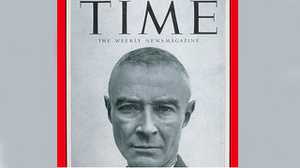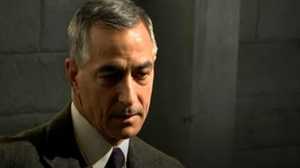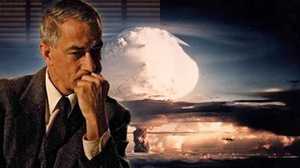Teacher's Guide
The Trials of J. Robert Oppenheimer offers insights into social studies topics including World War II, the Manhattan Project, the bombing of Hiroshima and Nagasaki and the end of the war, the Cold War and anti-communism, arms control, the nuclear age, the relationship between the military and the scientific establishment, and more. Use the program in your classroom, or delve into the rich resources available on the film’s Web site.
The Teacher’s Resources section offers four elements:
- a comprehension section for use with the programs
- classroom activities
- suggestions for completing the activities
Teachers are encouraged to adapt the guide to meet their own learning objectives for their students.
Comprehension
For each of the following statements, write T if it is true; if it is false, rewrite it so that it is true.
- Oppenheimer was born in 1904; his father was a Jewish immigrant from Russia.
- Oppenheimer’s parents recognized and encouraged his intellectual gifts from an early age.
- After studying theoretical physics in Germany, Oppenheimer returned to the United States and became a high school teacher.
- In the 1930s Oppenheimer had a relationship with Jean Tatlock, a member of the Communist Party.
- Oppenheimer joined the Communist Party while he was involved with Tatlock.
- In 1940 Oppenheimer married Kitty Harrison, a current Communist Party member.
- In 1942 General Leslie Groves selected Oppenheimer to head the secret “Manhattan Project” laboratory to design and built an atomic bomb.
- Oppenheimer, who had lived in Arizona and loved the area, suggested that the Manhattan Project site be built there.
- Haakon Chevalier, a friend of Oppenheimer’s, approached him while he was working at Los Alamos to obtain atomic secrets to pass on to France.
- Throughout Oppenheimer’s years with the Manhattan Project, Army intelligence continued to see him as a possible security risk.
- When Jean Tatlock asked Oppenheimer to visit her from Los Alamos in 1943, he refused.
- At Los Alamos, tension developed between Oppenheimer and Edward Teller because Teller wanted to focus on building a hydrogen bomb, not an atomic bomb.
- The world’s first nuclear explosion took place over the Japanese city of Hiroshima on August 6, 1945.
- After the invention of the atomic bomb, Oppenheimer favored international control over nuclear energy and the elimination of nuclear weapons.
- Oppenheimer opposed the development of a hydrogen bomb because he saw it as a weapon of genocide, not war.
- Lewis Strauss, who became chairman of the Atomic Energy Commission in 1953, was a strong supporter of Oppenheimer.
- When President Eisenhower suspended Oppenheimer’s security clearance, Oppenheimer insisted on a hearing to prove his innocence.
- The hearing gave Oppenheimer a fair opportunity to defend himself.
- During the hearing, Oppenheimer denied that he had lied to an army investigator during the war regarding possible Soviet interest in atomic secrets.
- The board determined that Oppenheimer was not a loyal American and revoked his security clearance.
Activity 1: The "Red Menace"?
Objective
To help students understand why many Americans felt threatened by the Soviet Union.
Activity
Divide the class into small groups and assign each group one of the two activities below. (Roughly equal numbers of groups should perform each activity.)
Activity A:
Working in small groups, write a brief summary (500-750 words) of the main events of the Russian Revolution of 1917. Your summary must use all of the terms in the five categories listed below.
Concepts: capitalism, dictatorship, proletariat, socialism, world revolution
Events: creation of USSR, October Revolution, Russian Civil War, World War I
Organizations: Bolshevik Party, Comintern, Communist Party of the Soviet Union
People: Vladimir Lenin, Karl Marx, Nicholas II, Joseph Stalin
Places: Russia, Soviet Union, St. Petersburg, Moscow
Activity B:
Working in small groups, write a brief summary (500-750 words) of the events leading to the Cold War. Your summary must use all of the terms in the five categories listed below.
Concepts: containment, Marshall Plan, Truman Doctrine
Events: Berlin Airlift, Cold War, Korean War, World War II
Organizations: NATO, Warsaw Pact
People: Winston Churchill, Adolf Hitler, Joseph Stalin, Harry Truman
Places: Berlin, Eastern Europe, Germany, “Iron Curtain,” Soviet Union, United States
Assessment
Call on selected groups to read their summaries to the class. Then discuss as a class:
- In what way was the creation of the Soviet Union a challenge to capitalist countries like the United States?
- How did events following World War II raise the danger of war between the United States and the Soviet Union?
- Was it reasonable for the U.S. government to be concerned about Oppenheimer’s possible connections with the American Communist Party or the Soviet Union? Why or why not?
Activity 2: "Death, Destroyer of Worlds"
Objective
To help students imagine how Oppenheimer might have felt personally about the atomic bombings of Japan.
Activity
View the film chapter chapter 8 “Los Alamos.” Then read this interview with a teenage victim of the atomic bombing of Nagasaki. Imagine that Oppenheimer read or heard this interview. What might he have said to Mr. Taniguchi in response? Write a letter from Oppenheimer to Taniguchi that explains how you think Oppenheimer would have reacted to the interview.
Assessment
Ask several volunteers to read their letters to the class. What are their similarities and differences? While Oppenheimer was working on the Manhattan Project, do you think he and the other scientists truly understood that the atomic bomb would cause the kind of suffering described in the letter? Why or why not?
Activity 3: "A Weapon of Genocide"
Objective
To help students understand the enormous destructive power of thermonuclear weapons.
Activity
View the film chapter “Genocide.” Then, as a class, examine the amount of destruction an H-bomb could cause if it hit your community. Begin by photocopying a map of the community and the surrounding area. Then, using information on the pressure damage and fallout that a 1-megaton thermonuclear bomb would cause, draw a series of rings around that central point at the distances described in the readings. (The pressure damage information, for example, describes the effects at 1.7, 2.7, 4.7, and 7.4 miles from the explosion.)
Examine the communities that lie within these circles. Roughly how many people live there?
Then do this same activity for other communities, such as major U.S. or world cities. On the board, create a chart listing your estimates for the number of casualties each city would suffer.
Assessment
Have the class review the chart on the board and then discuss this question: Oppenheimer opposed the development of the hydrogen bomb because he thought it would be too destructive to be a legitimate weapon of war. Do your findings support or contradict his view, and why?
Activity 4: Oppenheimer's Nemesis
Objective
To explore the relationship between Oppenheimer and Edward Teller.
Activity
View the film chapter “The Hearings.” Then, as a class, write and perform a play based on Edward Teller’s testimony against Oppenheimer in the 1954 Atomic Energy Commission hearing. The play should have three characters: Oppenheimer, Teller, and Roger Robb (the prosecutor who questioned Teller).
The lines spoken by Teller and Robb should be based on the transcript of the hearing. Select the portions of Teller’s testimony you think were most important in making the case against Oppenheimer.
In writing Oppenheimer’s lines, consider what thoughts might have been going through his mind while listening to Teller’s testimony and have him address these thoughts directly to the audience at various points during the testimony. For example, he might want to contradict a statement by Teller, or explain why Teller might want to ruin his reputation, or simply remember some event in his past that is relevant to the testimony.
The play’s final scene should be a brief conversation between Teller and Oppenheimer after Teller leaves the witness stand. (You may want to create a somewhat longer conversation than the one shown in the film.)
When the script is finished, select three students to play the three parts and perform the play for the class.
Assessment
After the play is performed, discuss as a class: Was the play consistent with the film in terms of how it portrayed Oppenheimer and Teller? Why or why not? Also, if you had been in either man’s position at the time of the hearing, would you have acted differently than he did? Why or why not?
Activity 5: Prophet of the Nuclear Age
Objective
To inform students about important issues in the news today concerning nuclear weapons and to consider how Oppenheimer might have responded to them.
Activity
Divide the class into five groups and assign each group one of the following topics: (1) North Korea’s nuclear weapons program, (2) Iran’s nuclear program, (3) tensions between the nuclear-armed countries of India and Pakistan, (4) the danger that terrorist groups will obtain a nuclear weapon, and (5) the large stockpiles of nuclear weapons that the United States and Russia still possess.
Each group should review recent news accounts and other sources to learn more about its assigned topic. Using this information, each group should prepare a five-minute oral briefing for the class explaining the issue and why it raises the possibility of nuclear war.
Assessment
After each group makes its presentation, discuss as a class: If Oppenheimer were alive today, what do you think he would say about this situation, and how might he recommend that the United States try to deal with it? Why?
Activity Hints
- Groups should feel free to include other concepts, events, etc. in their summaries as needed. You might want to follow up on this activity by having students find out when, how, and why the Soviet Union collapsed. Ask students if the fact that the Soviet Union no longer exists makes it more difficult to understand why many Americans once viewed it as a threat.
- Students’ letters should discuss issues where Oppenheimer presumably agreed with Mr. Taniguchi, as well as any issues where he might have disagreed with him.
- The U.S. Census Bureau’s Statistical Abstract provides population data for states and cities. The Census Bureau also provides population estimates for counties. Interested students may want to view videos of actual nuclear blasts to help them understand the enormous power of thermonuclear weapons.
- You may want to have Oppenheimer repeat a passage from the Bhagavad-Gita mentioned in the film: “In battle, in the forest, at the precipice in the mountains, / On the dark great sea, in the midst of javelins and arrows, / In sleep, in confusion, in the depths of shame, / The good deeds a man has done before defend him.” Why might he have seen this passage as especially meaningful in light of what happened at the hearing? You also may want to ask students who are unfamiliar with the term “nemesis” to look up its meaning. Do they think it is appropriate to say that Teller was Oppenheimer’s nemesis? Why or why not?
- The Web site of the PBS television show “NewsHour with Jim Lehrer” contains useful background information on North Korea, the threat of nuclear terrorism, and other topics. You might discuss as a class whether any of these situations would not exist today, or would be less serious, if U.S. leaders had followed Oppenheimer’s suggestions regarding nuclear arms and nuclear energy following World War II.









